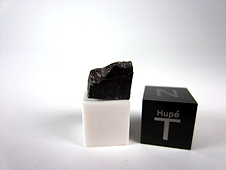NWA 2999 Angrite Meteorite

NWA 2999 is one of the most interesting Angrites ever found. It was brought back from a Moroccan expedition in August of 2004. This meteorite was not recognized as being anything exceptional until April of 2005, when Greg Hupé found time to investigate the entire haul from this trip. After examining hundreds of suspected meteorites he found 12 complete stones totaling 392 grams that looked somewhat different from the rest. Nobody would have guessed these stones would turn out to be ultra-rare Angrites, because texturally they look completely different from what most would expect. A sample was liberated from one of the stones and sent to Northern Arizona University and a second sample from a different stone was sent to the University of Washington. Both laboratories found that the mineral compositions matched those of Angrites. A decision was made to sample and test each of the 12 stones because the potential for additional important findings is great.
NWA 2999 is unique in having unusual mineral compositions that mimic terrestrial processes leaving some scientists to believe these types of stones could have only formed on a planet-sized body. Unlike most of the other known Angrites, NWA 2999 was found to be a plutonic rock, meaning that it formed underground and was not extruded in a lava flow. Interestingly enough, this sample lacks vesicles. The magnitude of these findings prompted scientists to send off a specimen to the Carnegie Institution in Washington D.C. for oxygen isotope testing. The results confirmed that NWA 2999 is the 10th member of the unusual and scarce Angrite group.
Here are some comments made by scientists:
"NWA 2999 is unique in many ways from other Angrites including LEW86010. I think we can make a valuable contribution to the understanding of Angrite origin/parent body characteristics!"
"This meteorite is unique among known Angrites. It is texturally very different from most Angrites in having a plutonic rather than volcanic or quench texture, and it lacks vesicles!"
NWA 2999 is featured in the November 2008 issue of "Astronomy" Magazine, along with angrites, NWA 4801 and NWA 4590 "Tamassint."
Meteoritical Bulletin entry for NWA 2999:
Click here for the Official classification of NWA 2999
NWA 2999 is unique in having unusual mineral compositions that mimic terrestrial processes leaving some scientists to believe these types of stones could have only formed on a planet-sized body. Unlike most of the other known Angrites, NWA 2999 was found to be a plutonic rock, meaning that it formed underground and was not extruded in a lava flow. Interestingly enough, this sample lacks vesicles. The magnitude of these findings prompted scientists to send off a specimen to the Carnegie Institution in Washington D.C. for oxygen isotope testing. The results confirmed that NWA 2999 is the 10th member of the unusual and scarce Angrite group.
Here are some comments made by scientists:
"NWA 2999 is unique in many ways from other Angrites including LEW86010. I think we can make a valuable contribution to the understanding of Angrite origin/parent body characteristics!"
"This meteorite is unique among known Angrites. It is texturally very different from most Angrites in having a plutonic rather than volcanic or quench texture, and it lacks vesicles!"
NWA 2999 is featured in the November 2008 issue of "Astronomy" Magazine, along with angrites, NWA 4801 and NWA 4590 "Tamassint."
Meteoritical Bulletin entry for NWA 2999:
Click here for the Official classification of NWA 2999
Copyright 2012 - Current All Rights Reserved Nature's Vault, Inc.





